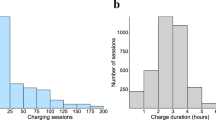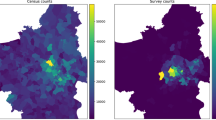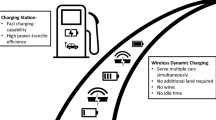Abstract
By displacing gasoline and diesel fuels, electric cars and fleets reduce emissions from the transportation sector, thus offering important public health benefits. However, public confidence in the reliability of charging infrastructure remains a fundamental barrier to adoption. Using large-scale social data and machine-learning based on 12,720 electric vehicle (EV) charging stations, we provide national evidence on how well the existing charging infrastructure is serving the needs of the rapidly expanding population of EV drivers in 651 core-based statistical areas in the United States. We deploy supervised machine-learning algorithms to automatically classify unstructured text reviews generated by EV users. Extracting behavioural insights at a population scale has been challenging given that streaming data can be costly to hand classify. Using computational approaches, we reduce processing times for research evaluation from weeks of human processing to just minutes of computation. Contrary to theoretical predictions, we find that stations at private charging locations do not outperform public charging locations provided by the government. Overall, nearly half of drivers who use mobility applications have faced negative experiences at EV charging stations in the early growth years of public charging infrastructure, a problem that needs to be fixed as the market for electrified and sustainable transportation expands.
This is a preview of subscription content, access via your institution
Access options
Access Nature and 54 other Nature Portfolio journals
Get Nature+, our best-value online-access subscription
$29.99 / 30 days
cancel any time
Subscribe to this journal
Receive 12 digital issues and online access to articles
$119.00 per year
only $9.92 per issue
Buy this article
- Purchase on Springer Link
- Instant access to full article PDF
Prices may be subject to local taxes which are calculated during checkout





Similar content being viewed by others
Data availability
We provide the weights of the trained deep-learning models. These datasets generated and/or analysed during the current study are available in the Figshare repository https://doi.org/10.6084/m9.figshare.1204467056. The raw data that support the findings of this study are available from the corresponding author upon request. These data may not be posted publicly due to privacy restrictions. For interested readers, an alternative open data API service with global EV charging infrastructure data is available from OpenChargeMap (https://openchargemap.org/), which is derived from a variety of public sources and contributions. Source Data are provided with this paper.
Code availability
All custom code and algorithm replication materials have been deposited on the Github repository using Zenodo version releases at https://doi.org/10.5281/zenodo.1419830.
References
Market Data: EV Market Forecasts: Global Forecasts for Light Duty Plug-In Hybrid and Battery EV Sales and Populations: 2018–2030 (Navigant, 2019).
Inventory of US Greenhouse Gas Emissions and Sinks: 1990-2016 Document No. 430-R-18-003 (EPA, 2018).
The electric battery vehicle. Nature 144, 627 (1939).
Michalek, J. J. et al. Valuation of plug-in vehicle life-cycle air emissions and oil displacement benefits. Proc. Natl Acad. Sci. USA 108, 16554–16558 (2011).
Tessum, C. W., Hill, J. D. & Marshall, J. D. Life cycle air quality impacts of conventional and alternative light-duty transportation in the United States. Proc. Natl Acad. Sci. USA 111, 18490–18495 (2014).
Holland, S. P., Mansur, E. T., Muller, N. Z. & Yates, A. J. Are there environmental benefits from driving electric vehicles? The importance of local factors. Am. Econ. Rev. 106, 3700–3729 (2016).
Li, S., Tong, L., Xing, J. & Zhou, Y. The market for electric vehicles: indirect network effects and policy design. J. Assoc. Environ. Resour. Econ. 4, 89–133 (2017).
Andreoni, J. Impure altruism and donations to public goods: a theory of warm-glow giving. Econ. J. 100, 464–477 (1990).
Kotchen, M. Green markets and private provision of public goods. J. Political Econ. 114, 816–834 (2006).
Warner, M. & Amir, H. Managing markets for public service: the role of mixed public–private delivery of city services. Public Adm. Rev. 68, 155–166 (2008).
Warner, M. & Hebdon, R. Local government restructuring: privatization and its alternatives. J. Policy Anal. Manag. 20, 315–336 (2001).
Carley, S., Krause, R. M., Lane, B. W. & Graham, J. D. Intent to purchase a plug-in electric vehicle: a survey of early impressions in large US cites. Transp. Res. Part D 18, 39–45 (2013).
Sovacool, B. K. & Hirsh, R. F. Beyond batteries: an examination of the benefits and barriers to plug-in hybrid electric vehicles (PHEVS) and a vehicle-to-grid (V2G) transition. Energy Policy 37, 1095–1103 (2009).
Helveston, J. P. et al. Choice at the pump: measuring preferences for lower-carbon combustion fuels. Environ. Res. Lett. 14, 084035 (2019).
Xu, Y., Çolak, S., Kara, E. C., Moura, S. J. & González, M. C. Planning for electric vehicle needs by coupling charging profiles with urban mobility. Nat. Energy 3, 484–493 (2018).
Asensio, O. I. Correcting consumer misperception. Nat. Energy 4, 823–824 (2019).
Williams, B. & DeShazo, J. Pricing workplace charging: financial viability and fueling costs. Transp. Res. Rec. 2454, 68–75 (2014).
Asensio, O. I. & Delmas, M. A. Nonprice incentives and energy conservation. Proc. Natl Acad. Sci. USA 112, E510–E515 (2015).
Asensio, O. I. & Delmas, M. A. The dynamics of behavior change: evidence from energy conservation. J. Econ. Behav. Organ. 126, 196–212 (2016).
Alexander, L., Jiang, S., Murga, M. & González, M. C. Origin–destination trips by purpose and time of day inferred from mobile phone data. Transp. Res. Part C 58, 240–250 (2015).
González, M. C., Hidalgo, C. A. & Barabasi, A.-L. Understanding individual human mobility patterns. Nature 453, 779–782 (2008).
Kim, Y. Convolutional neural networks for sentence classification. In Proc. 2014 Conference on Empirical Methods in Natural Language Processing (EMNLP) (eds Moschitti, A. et al.) 1746–1751 (Association for Computational Linguistics, 2014).
LeCun, Y., Bengio, Y. & Hinton, G. Deep learning. Nature 521, 436–444 (2015).
Socher, R. et al. Recursive deep models for semantic compositionality over a sentiment treebank. In Proc. 2013 Conference on Empirical Methods in Natural Language Processing (eds Yarowsky, D. et al.) 1631–1642 (2013).
dos Santos, C. & Gatti, M. Deep convolutional neural networks for sentiment analysis of short texts. In Proc. COLING 2014, the 25th International Conference on Computational Linguistics: Technical Papers (eds Tsujii, J. & Hajic, J.) 69–78 (Dublin City University and Association for Computational Linguistics, 2014).
Yih, W.-t., Toutanova, K., Platt, J. C. & Meek, C. Learning discriminative projections for text similarity measures. In Proc. Fifteenth Conference on Computational Natural Language Learning (ed. Pradhan, S.) 247–256 (Association for Computational Linguistics, 2011).
Shen, Y., He, X., Gao, J., Deng, L. & Mesnil, G. Learning semantic representations using convolutional neural networks for web search. In Proc. 23rd International Conference on World Wide Web (ed. Chung, C.-W.) 373–374 (ACM, 2014).
Kalchbrenner, N., Grefenstette, E., & Blunsom, P. A convolutional neural network for modelling sentences. In Proc. 52nd Annual Meeting of the Association for Computational Linguistics (eds Toutanova, K. and Wu, H.) 655–665 (Association for Computational Linguistics, 2014).
Collobert, R. et al. Natural language processing (almost) from scratch. J. Mach. Learn. Res. 12, 2493–2537 (2011).
Mikolov, T., Sutskever, I., Chen, K., Corrado, G. S. & Dean, J. in Advances in Neural Information Processing Systems (eds Burges, C. J. C. et al.) 3111–3119 (Curran Associates, Inc., 2013).
Hochreiter, S. & Schmidhuber, J. Long short-term memory. Neural Comput. 9, 1735–1780 (1997).
Yin, W., Kann, K., Yu, M. & Schütze, H. Comparative study of CNN and RNN for natural language processing. Preprint at http://arXiv.org/abs/arXiv:1702.01923 (2017).
Li, J., Chen, X., Hovy, E. & Jurafsky, D. Visualizing and understanding neural models in NLP. In Proc. 2016 Conference of the North American Chapter of the Association for Computational Linguistics: Human Language Technologies (eds Knight, K. et al.) 681–691 (Association for Computational Linguistics, 2016).
Tixier, A. J.-P. Notes on deep learning for NLP. Preprint at http://arXiv.org/abs/arXiv:1808.09772 (2018).
Song, B., Lee, C., Yoon, B. & Park, Y. Diagnosing service quality using customer reviews: an index approach based on sentiment and gap analyses. Serv. Bus. 10, 775–798 (2016).
Wang, H., Can, D., Kazemzadeh, A., Bar, F. & Narayanan, S. A system for real-time Twitter sentiment analysis of 2012 US presidential election cycle. In Proc. ACL 2012 System Demonstrations (ed. Zhang, M.) 115–120 (Association for Computational Linguistics, 2012).
Hopkins, D. J. & King, G. A method of automated nonparametric content analysis for social science. Am. J. Political Sci. 54, 229–247 (2010).
Bail, C. A. The cultural environment: measuring culture with big data. Theory Soc. 43, 465–482 (2014).
Ulibarri, N., Scott, T. A. & Perez-Figueroa, O. How does stakeholder involvement affect environmental impact assessment? Environ. Impact Assess. Rev. 79, 106309 (2019).
Board, T. R. & Council, N. R. Overcoming Barriers to Deployment of Plug-in Electric Vehicles (National Academies Press, 2015).
Gerardo Zarazua de Rubens, L. N. & Sovacool, B. K. Dismissive and deceptive car dealerships create barriers to electric vehicle adoption at the point of sale. Nat. Energy 3, 501–507 (2018).
Rezvani, Z., Jansson, J. & Bodin, J. Advances in consumer electric vehicle adoption research: a review and research agenda. Transp. Res. Part D 34, 122–136 (2015).
Plug-In Electric Vehicle Deployment Policy Tools: Zoning, Codes, and Parking Ordinances Technology Bulletin (DOE, 2015).
National Plug-In Electric Vehicle Infrastructure Analysis (DOE, 2017).
DeShazo, J. R. Improving incentives for clean vehicle purchases in the United States: challenges and opportunities. Rev. Environ. Econ. Policy 10, 149–165 (2016).
DeShazo, J., Sheldon, T. L. & Carson, R. T. Designing policy incentives for cleaner technologies: lessons from California’s plug-in electric vehicle rebate program. J. Environ. Econ. Manag. 84, 18–43 (2017).
Zhang, Y. & Wallace, B. C. A sensitivity analysis of (and practitioners’ guide to) convolutional neural networks for sentence classification. In Proc. Eighth International Joint Conference on Natural Language Processing (eds Kondrak, G. & Watanabe, T.) 253–263 (Asian Federation of Natural Language Processing, 2017).
Srivastava, N., Hinton, G., Krizhevsky, A., Sutskever, I. & Salakhutdinov, R. Dropout: a simple way to prevent neural networks from overfitting. J. Mach. Learn. Res. 15, 1929–1958 (2014).
Karpathy, A., Johnson, J. & Fei-Fei, L. Visualizing and understanding recurrent networks. In International Conference on Learning Representations 2016 Workshop (International Conference on Learning Representations, 2016).
Cohen, J. A coefficient of agreement for nominal scales. Educ. Psychol. Meas. 20, 37–46 (1960).
Papke, L. E. & Wooldridge, J. M. Econometric methods for fractional response variables with an application to 401(k) plan participation rates. J. Appl. Econ. 11, 619–632 (1996).
Papke, L. E. & Wooldridge, J. M. Panel data methods for fractional response variables with an application to test pass rates. J. Econ. 145, 121–133 (2008).
Ramalho, E. A., Ramalho, J. J. & Murteira, J. M. Alternative estimating and testing empirical strategies for fractional regression models. J. Econ. Surv. 25, 19–68 (2011).
2010 Census Urban and Rural Classification and Urban Area Criteria (US Census, 2010).
Conneau, A., Schwenk, H., Barrault, L. & Lecun, Y. Very deep convolutional networks for text classification. In Proc. 15th Conference of the European Chapter of the Association for Computational Linguistics Vol. 1 (eds Lapata, M. et al.) 1107–1116 (Association for Computational Linguistics, 2017).
Asensio, O. I. & Ha, S. Trained CNN and LSTM model on EV charging station reviews for sentiment analysis (Figshare, 2020); https://doi.org/10.6084/m9.figshare.12044670
Acknowledgements
This research was supported by a grant from the National Science Foundation (CPS award no. 1931980), the Civic Data Science REU programme at Georgia Tech (NSF award no. IIS-1659757), the Anthony and Jeanne Pritzker Family Foundation, the Sustainable LA Grand Challenge. We are grateful to E. Zegura and C. Le Dantec for discussions. For valuable research assistance, we thank M. E. Burke, S. Dharur, S. Oh and D. Marchetto. Special thanks to N. Hajjar.
This research was also supported in part through research cyberinfrastructure resources and services provided by the Partnership for an Advanced Computing Environment (PACE) at the Georgia Institute of Technology, Atlanta, Georgia, USA.
Author information
Authors and Affiliations
Contributions
O.I.A. directed the research and wrote the paper; A.D., E.W. and K.A. developed code, analysed data and wrote the paper; K.A., C.H. and S.H. implemented algorithms and performed experiments; S.H. investigated model validation and interpretability. All authors reviewed the manuscript.
Corresponding author
Ethics declarations
Competing interests
The authors declare no competing interests.
Additional information
Publisher’s note Springer Nature remains neutral with regard to jurisdictional claims in published maps and institutional affiliations.
Extended data
Extended Data Fig. 1 Distribution of CNN classifier predictions for 1,000 model runs.
The mean test accuracy for 1,000 runs is 84.6% with a S.D. of 0.79.
Extended Data Table 1 Descriptive statistics, public and private.
Counts of machine classified reviews of binary sentiment by public and private ownership. 2,256 reviews were submitted in locations where it was impossible to discern whether it was public or private.
Extended Data Table 2 Main results.
FRM results for the review rate and negativity score.
Extended Data Table 3 Descriptive statistics, urban and rural.
Counts of machine classified reviews of binary sentiment by geographic area type as defined by U.S. Census designations.
Extended Data Table 4 Probability of negative sentiment for 18 core-based statistical areas in the United States.
Results of t-tests for free and paid stations by public and private ownership in 18 CBSAs in the United States.
Extended Data Table 5 Probability of negative sentiment for top 20 U.S. states.
Results of t-tests for free and paid stations by public and private ownership in the top 20 states by number of reviews.
Extended Data Table 6 Balance of training data.
Counts of positive and negative reviews by two human annotators (κ=0.84).
Supplementary information
Supplementary Information
Supplementary discussion, Fig. 1, Tables 1–7 and references.
Source data
Source Data Fig. 1
Contains state ID and number of reviews.
Source Data Fig. 3
Contains the weights of the trained CNN model used to create the heatmap figure
Source Data Fig. 4
Contains location ID, Public or Private designations, Free or Paid Designations
Source Data Fig. 5
Contains location ID, U.S. Census area type, point of interest, and predicted sentiment
Source Data Extended Data Fig. 1
Contains 1000 CNN performance runs with accuracy in percentage
Source Data Extended Data Table 1
Contains location ID, public or private designations, predicted sentiment
Source Data Extended Data Table 3
Contains location ID, U.S. Census area type, and predicted sentiment per review
Source Data Extended Data Table 4
CBSA, free or paid designations, public or private designations, and predicted sentiment per review
Source Data Extended Data Table 5
Public or private designations, free or paid designations, state, predicted sentiment per review
Source Data Extended Data Table 6
Contains review ID and human expert labels positive or negative
Rights and permissions
About this article
Cite this article
Asensio, O.I., Alvarez, K., Dror, A. et al. Real-time data from mobile platforms to evaluate sustainable transportation infrastructure. Nat Sustain 3, 463–471 (2020). https://doi.org/10.1038/s41893-020-0533-6
Received:
Accepted:
Published:
Issue Date:
DOI: https://doi.org/10.1038/s41893-020-0533-6
This article is cited by
-
Effects of expanding electric vehicle charging stations in California on the housing market
Nature Sustainability (2023)
-
Electric charging station management using IoT and cloud computing framework for sustainable green transportation
Multimedia Tools and Applications (2023)
-
Impacts of micromobility on car displacement with evidence from a natural experiment and geofencing policy
Nature Energy (2022)
-
Shared electric scooters and electric bikes can reduce traffic in urban centres
Nature Energy (2022)
-
Forecasting the evolution of fast-changing transportation networks using machine learning
Nature Communications (2022)



